How Do You Do the Splits? A Safe, Step-by-Step Guide for Beginners
June 13th, 2025

If you've ever watched a martial artist drop into a full side split and thought, "There's no way my legs bend like that," you're definitely not alone. Learning how to do the splits takes time, consistency, and most of all, patience. Whether you're training for martial arts, gymnastics, dance, or just want to boost your overall flexibility, the splits are one of those milestones that make you feel like your body has unlocked a new level.
But let's be real, it's not as simple as just forcing your legs apart. Doing the splits safely means preparing your body the right way, stretching the right muscles, and understanding your limits. If you try to rush it or skip the essentials, you're setting yourself up for injury, especially in sensitive areas like the groin or hamstrings. This guide will walk you through each step, from warm-ups to full splits, and show you how to get there safely, with help from tools like leg stretchers and flexibility gear.
Disclaimer: This article is for informational purposes only. Always consult a medical or fitness professional before beginning any stretching or flexibility routine. Improper stretching can lead to injury.
Before you even think about dropping into a stretch, your body needs to be warm. Stretching cold muscles is a recipe for injury, especially if you're targeting tight areas like the hips, hamstrings, or groin. A solid warm-up doesn't need to be long or complicated; 5 to 10 minutes is usually enough.
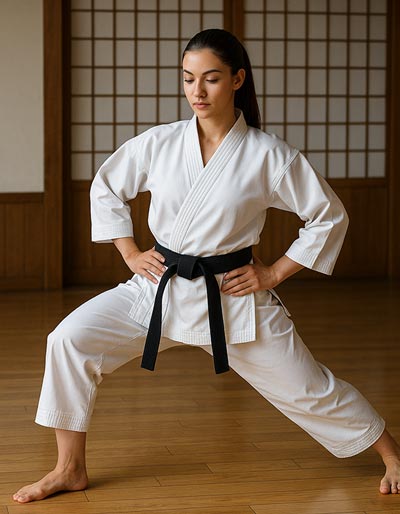
Start with some light movement to raise your body temperature. Jog in place, jump rope, or do jumping jacks to get your blood flowing. Once you're warm, ease into dynamic stretches like leg swings, walking lunges, or hip circles. These get your joints moving and prepare your body for the deeper flexibility work to come.
The key here is movement. This isn't the time for deep static holds; those come later. The goal is to activate your muscles, increase circulation, and reduce your risk of pulling something once you start stretching for real.
Once you're warmed up, it's time to start targeting the muscles that will actually get you closer to doing the splits. And one of the most important areas? Your hamstrings. Tight hamstrings are one of the biggest roadblocks when learning how to do the splits, especially for people who sit a lot during the day or haven't stretched consistently.
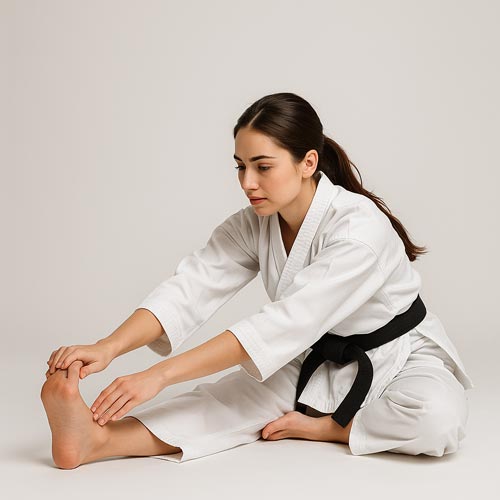
Start with a simple seated hamstring stretch. Sit on the floor with one leg extended straight in front of you and the other leg bent, foot tucked against your thigh. Lean forward over your straight leg, reaching toward your foot, and keep your back as straight as possible. The stretch should be felt in the back of your thigh, not your lower back.
Hold the stretch for 20 to 30 seconds, then switch legs. Don't bounce or force it; this isn't a race. The goal is to loosen up the hamstrings so your legs can eventually extend farther apart without strain.
If your inner thighs feel tight every time you try to stretch, you're not imagining it. The muscles along your inner thighs, called adductors, are some of the most stubborn when it comes to flexibility, especially for martial artists working toward the side split. That's why groin stretches are such a crucial part of your routine.
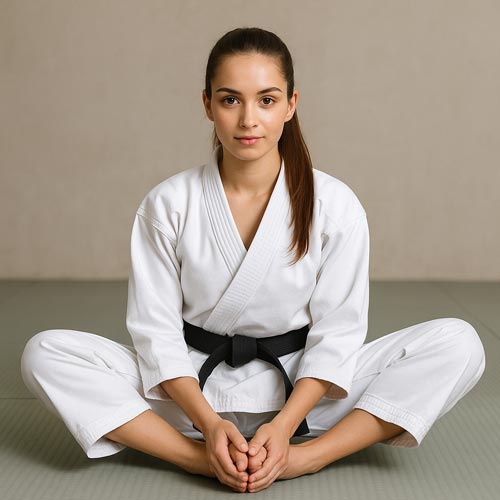
One of the most effective and beginner-friendly options is the butterfly stretch. Sit on the floor with your feet pressed together and knees bent out to the sides. Pull your heels in toward your body as far as is comfortable, and gently press your knees toward the ground using your elbows. Keep your spine tall and avoid leaning forward too far.
You should feel a deep stretch along your inner thighs, but no pain. This is a great position to hold for 30-60 seconds and breathe through the tension. Over time, this stretch will help you get closer to a full side split by loosening up the groin and increasing your hip mobility.
Once your hamstrings and groin are loosened up, it's time to work on the side-to-side flexibility that helps you sink deeper into a straddle or side split. The side lunge, also called a lateral lunge, is perfect for this. It stretches the inner thighs, strengthens your glutes, and improves balance all at the same time.
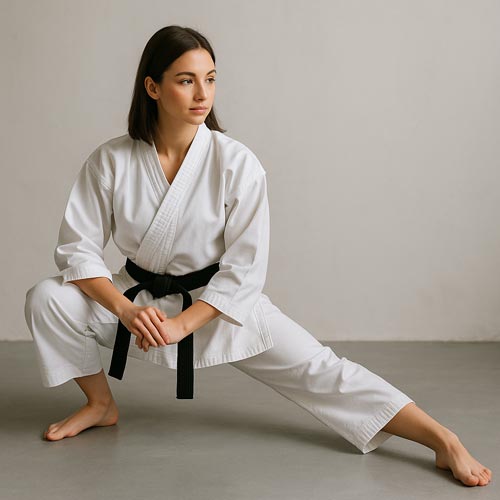
Start standing with your feet wide apart. Shift your weight over one leg, bending that knee while keeping the other leg straight. Keep your chest lifted and your hips back like you're sitting into a squat. Try to sink as low as possible while keeping your heel flat and your toes pointing forward.
You should feel a stretch through the inner thigh of your straight leg and a bit of a challenge through the bent leg. Hold the position for a few seconds, then return to center and repeat on the other side. Do a few reps per leg to help increase your hip range of motion and prepare for deeper flexibility training.
The straddle stretch is where everything starts to come together. It closely mimics the position of a full side split, but in a controlled, seated position that gives you better leverage and reduces the risk of injury. If you're working toward a flat split, this stretch needs to be in your regular routine.
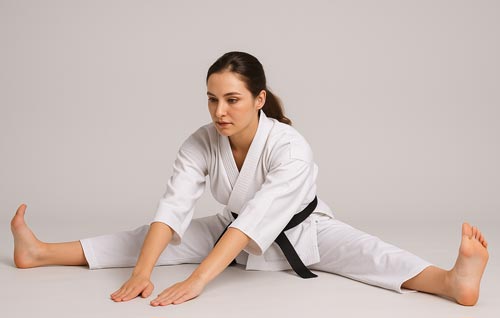
To do it, sit on the floor and open your legs as wide as comfortably possible, keeping your knees facing up and your toes pointed toward the ceiling. Sit tall through your spine. From here, you can slowly lean forward, reaching your hands out in front of you, or walk your hands to each leg one at a time. The key is to move gradually and stay in control; no bouncing or forcing it.
You'll feel this stretch in your inner thighs, hamstrings, and hips. It's great for building endurance in those muscles, which is important for holding deep positions like the splits. As your flexibility improves, you'll be able to reach farther and get closer to the ground. Over time, this stretch will help you transition smoothly into a full split.
You've warmed up, stretched your hamstrings, opened up your groin, and worked on your hip mobility. Now you're ready to give the full side split a try. But here's the deal: don't force it. Flexibility takes time, and pushing too hard too soon can do more harm than good.
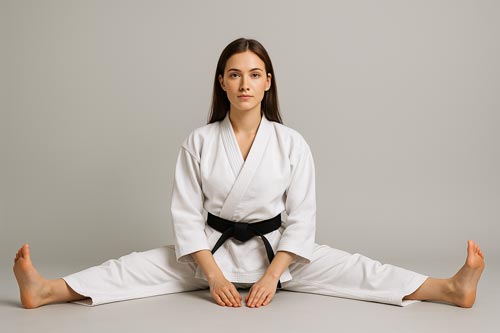
Start by lowering yourself into a split slowly. You can do this on the floor, using your hands for support on either side. Your legs should extend out to each side in a straight line, knees facing up, and toes pointed toward the ceiling. Go as far as your body allows while keeping your form tight; no twisting or collapsing.
If you're not close to the ground yet, that's totally fine. Stay where you feel a deep stretch, breathe through it, and hold the position for 20 to 60 seconds. Over time, as your muscles adapt, you'll naturally sink deeper. You can also use tools like a leg stretching machine to support your progress and help you ease into the full position with more control and less strain.
Remember, consistency matters more than depth. Doing the splits isn't about showing off; it's about building control, mobility, and confidence in your body.
Doing the splits isn't something that happens overnight, and that's okay. The key is consistency, patience, and using the right techniques. Stick with a structured routine like this one, stretch after every workout, and give your body time to adapt. Everyone progresses at a different pace, so don't compare your timeline to someone else's.
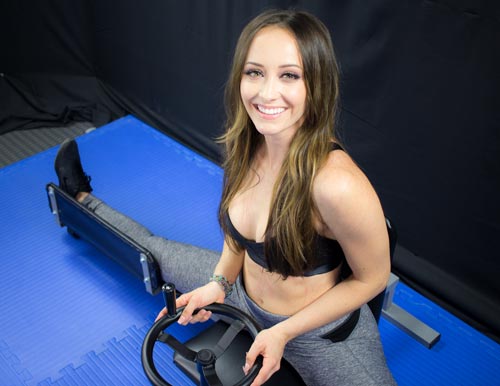
If you're serious about getting deeper into your splits, it might be worth investing in a leg stretching machine. Tools like a split stretch machine, martial arts leg stretcher, or adductor stretcher help you hold positions longer and stretch more effectively without putting strain on your joints. They're especially useful for martial artists, gymnasts, and anyone doing regular flexibility training.
Whether you're using stretching aids or just working through this routine on the floor, the most important thing is that you're doing it safely. Never force a stretch, and always listen to your body. Keep at it, train smart, and you'll be surprised how far your flexibility can go.
Disclaimer: This article is for informational purposes only. Always consult a medical or fitness professional before beginning any stretching or flexibility routine. Improper stretching can lead to injury.
Start With a Proper Warm-Up
Before you even think about dropping into a stretch, your body needs to be warm. Stretching cold muscles is a recipe for injury, especially if you're targeting tight areas like the hips, hamstrings, or groin. A solid warm-up doesn't need to be long or complicated; 5 to 10 minutes is usually enough.

Start with some light movement to raise your body temperature. Jog in place, jump rope, or do jumping jacks to get your blood flowing. Once you're warm, ease into dynamic stretches like leg swings, walking lunges, or hip circles. These get your joints moving and prepare your body for the deeper flexibility work to come.
The key here is movement. This isn't the time for deep static holds; those come later. The goal is to activate your muscles, increase circulation, and reduce your risk of pulling something once you start stretching for real.
Stretch Your Hamstrings First
Once you're warmed up, it's time to start targeting the muscles that will actually get you closer to doing the splits. And one of the most important areas? Your hamstrings. Tight hamstrings are one of the biggest roadblocks when learning how to do the splits, especially for people who sit a lot during the day or haven't stretched consistently.

Start with a simple seated hamstring stretch. Sit on the floor with one leg extended straight in front of you and the other leg bent, foot tucked against your thigh. Lean forward over your straight leg, reaching toward your foot, and keep your back as straight as possible. The stretch should be felt in the back of your thigh, not your lower back.
Hold the stretch for 20 to 30 seconds, then switch legs. Don't bounce or force it; this isn't a race. The goal is to loosen up the hamstrings so your legs can eventually extend farther apart without strain.
Open Up with a Groin Stretch
If your inner thighs feel tight every time you try to stretch, you're not imagining it. The muscles along your inner thighs, called adductors, are some of the most stubborn when it comes to flexibility, especially for martial artists working toward the side split. That's why groin stretches are such a crucial part of your routine.

One of the most effective and beginner-friendly options is the butterfly stretch. Sit on the floor with your feet pressed together and knees bent out to the sides. Pull your heels in toward your body as far as is comfortable, and gently press your knees toward the ground using your elbows. Keep your spine tall and avoid leaning forward too far.
You should feel a deep stretch along your inner thighs, but no pain. This is a great position to hold for 30-60 seconds and breathe through the tension. Over time, this stretch will help you get closer to a full side split by loosening up the groin and increasing your hip mobility.
Build Lateral Flexibility with Side Lunges
Once your hamstrings and groin are loosened up, it's time to work on the side-to-side flexibility that helps you sink deeper into a straddle or side split. The side lunge, also called a lateral lunge, is perfect for this. It stretches the inner thighs, strengthens your glutes, and improves balance all at the same time.

Start standing with your feet wide apart. Shift your weight over one leg, bending that knee while keeping the other leg straight. Keep your chest lifted and your hips back like you're sitting into a squat. Try to sink as low as possible while keeping your heel flat and your toes pointing forward.
You should feel a stretch through the inner thigh of your straight leg and a bit of a challenge through the bent leg. Hold the position for a few seconds, then return to center and repeat on the other side. Do a few reps per leg to help increase your hip range of motion and prepare for deeper flexibility training.
Train Your Split with the Straddle Stretch
The straddle stretch is where everything starts to come together. It closely mimics the position of a full side split, but in a controlled, seated position that gives you better leverage and reduces the risk of injury. If you're working toward a flat split, this stretch needs to be in your regular routine.

To do it, sit on the floor and open your legs as wide as comfortably possible, keeping your knees facing up and your toes pointed toward the ceiling. Sit tall through your spine. From here, you can slowly lean forward, reaching your hands out in front of you, or walk your hands to each leg one at a time. The key is to move gradually and stay in control; no bouncing or forcing it.
You'll feel this stretch in your inner thighs, hamstrings, and hips. It's great for building endurance in those muscles, which is important for holding deep positions like the splits. As your flexibility improves, you'll be able to reach farther and get closer to the ground. Over time, this stretch will help you transition smoothly into a full split.
Attempt the Side Split (With Patience)
You've warmed up, stretched your hamstrings, opened up your groin, and worked on your hip mobility. Now you're ready to give the full side split a try. But here's the deal: don't force it. Flexibility takes time, and pushing too hard too soon can do more harm than good.

Start by lowering yourself into a split slowly. You can do this on the floor, using your hands for support on either side. Your legs should extend out to each side in a straight line, knees facing up, and toes pointed toward the ceiling. Go as far as your body allows while keeping your form tight; no twisting or collapsing.
If you're not close to the ground yet, that's totally fine. Stay where you feel a deep stretch, breathe through it, and hold the position for 20 to 60 seconds. Over time, as your muscles adapt, you'll naturally sink deeper. You can also use tools like a leg stretching machine to support your progress and help you ease into the full position with more control and less strain.
Remember, consistency matters more than depth. Doing the splits isn't about showing off; it's about building control, mobility, and confidence in your body.
Stretch Consistently and Use the Right Tools
Doing the splits isn't something that happens overnight, and that's okay. The key is consistency, patience, and using the right techniques. Stick with a structured routine like this one, stretch after every workout, and give your body time to adapt. Everyone progresses at a different pace, so don't compare your timeline to someone else's.

If you're serious about getting deeper into your splits, it might be worth investing in a leg stretching machine. Tools like a split stretch machine, martial arts leg stretcher, or adductor stretcher help you hold positions longer and stretch more effectively without putting strain on your joints. They're especially useful for martial artists, gymnasts, and anyone doing regular flexibility training.
Whether you're using stretching aids or just working through this routine on the floor, the most important thing is that you're doing it safely. Never force a stretch, and always listen to your body. Keep at it, train smart, and you'll be surprised how far your flexibility can go.
You May Also Be Interested In:
Leave a Reply






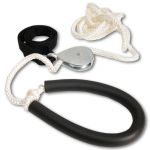

 (1)
(1)



















